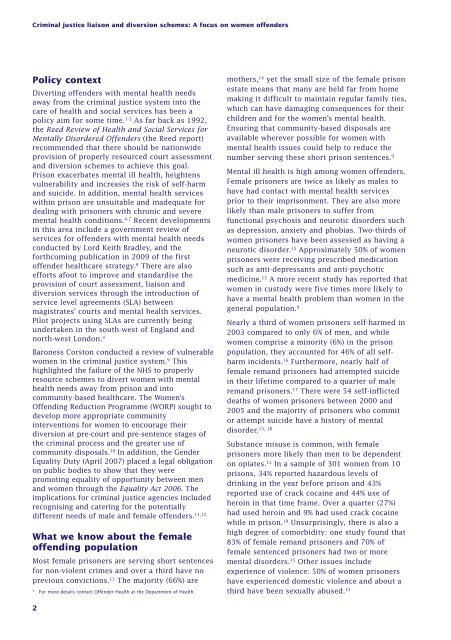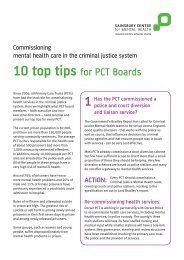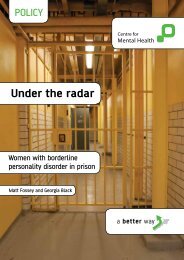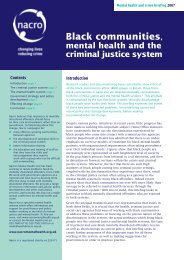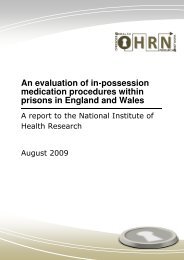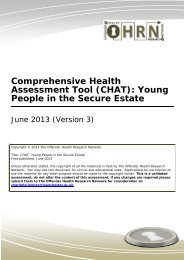Criminal justice liaison and diversion schemes - Offender Health ...
Criminal justice liaison and diversion schemes - Offender Health ...
Criminal justice liaison and diversion schemes - Offender Health ...
Create successful ePaper yourself
Turn your PDF publications into a flip-book with our unique Google optimized e-Paper software.
<strong>Criminal</strong> <strong>justice</strong> <strong>liaison</strong> <strong>and</strong> <strong>diversion</strong> <strong>schemes</strong>: A focus on women offendersPolicy contextDiverting offenders with mental health needsaway from the criminal <strong>justice</strong> system into thecare of health <strong>and</strong> social services has been apolicy aim for some time. 1-3 As far back as 1992,the Reed Review of <strong>Health</strong> <strong>and</strong> Social Services forMentally Disordered <strong>Offender</strong>s (the Reed report)recommended that there should be nationwideprovision of properly resourced court assessment<strong>and</strong> <strong>diversion</strong> <strong>schemes</strong> to achieve this goal.Prison exacerbates mental ill health, heightensvulnerability <strong>and</strong> increases the risk of self-harm<strong>and</strong> suicide. In addition, mental health serviceswithin prison are unsuitable <strong>and</strong> inadequate fordealing with prisoners with chronic <strong>and</strong> severemental health conditions. 4-7 Recent developmentsin this area include a government review ofservices for offenders with mental health needsconducted by Lord Keith Bradley, <strong>and</strong> theforthcoming publication in 2009 of the firstoffender healthcare strategy. 8 There are alsoefforts afoot to improve <strong>and</strong> st<strong>and</strong>ardise theprovision of court assessment, <strong>liaison</strong> <strong>and</strong><strong>diversion</strong> services through the introduction ofservice level agreements (SLA) betweenmagistrates’ courts <strong>and</strong> mental health services.Pilot projects using SLAs are currently beingundertaken in the south-west of Engl<strong>and</strong> <strong>and</strong>north-west London.*Baroness Corston conducted a review of vulnerablewomen in the criminal <strong>justice</strong> system. 9 Thishighlighted the failure of the NHS to properlyresource <strong>schemes</strong> to divert women with mentalhealth needs away from prison <strong>and</strong> intocommunity-based healthcare. The Women’sOffending Reduction Programme (WORP) sought todevelop more appropriate communityinterventions for women to encourage their<strong>diversion</strong> at pre-court <strong>and</strong> pre-sentence stages ofthe criminal process <strong>and</strong> the greater use ofcommunity disposals. 10 In addition, the GenderEquality Duty (April 2007) placed a legal obligationon public bodies to show that they werepromoting equality of opportunity between men<strong>and</strong> women through the Equality Act 2006. Theimplications for criminal <strong>justice</strong> agencies includedrecognising <strong>and</strong> catering for the potentiallydifferent needs of male <strong>and</strong> female offenders. 11,12What we know about the femaleoffending populationMost female prisoners are serving short sentencesfor non-violent crimes <strong>and</strong> over a third have noprevious convictions. 13 The majority (66%) are* For more details contact <strong>Offender</strong> <strong>Health</strong> at the Department of <strong>Health</strong>.mothers, 14 yet the small size of the female prisonestate means that many are held far from homemaking it difficult to maintain regular family ties,which can have damaging consequences for theirchildren <strong>and</strong> for the women’s mental health.Ensuring that community-based disposals areavailable wherever possible for women withmental health issues could help to reduce thenumber serving these short prison sentences. 9Mental ill health is high among women offenders.Female prisoners are twice as likely as males tohave had contact with mental health servicesprior to their imprisonment. They are also morelikely than male prisoners to suffer fromfunctional psychosis <strong>and</strong> neurotic disorders suchas depression, anxiety <strong>and</strong> phobias. Two-thirds ofwomen prisoners have been assessed as having aneurotic disorder. 15 Approximately 50% of womenprisoners were receiving prescribed medicationsuch as anti-depressants <strong>and</strong> anti-psychoticmedicine. 15 A more recent study has reported thatwomen in custody were five times more likely tohave a mental health problem than women in thegeneral population. 9Nearly a third of women prisoners self-harmed in2003 compared to only 6% of men, <strong>and</strong> whilewomen comprise a minority (6%) in the prisonpopulation, they accounted for 46% of all selfharmincidents. 16 Furthermore, nearly half offemale rem<strong>and</strong> prisoners had attempted suicidein their lifetime compared to a quarter of malerem<strong>and</strong> prisoners. 17 There were 54 self-inflicteddeaths of women prisoners between 2000 <strong>and</strong>2005 <strong>and</strong> the majority of prisoners who commitor attempt suicide have a history of mental13, 18disorder.Substance misuse is common, with femaleprisoners more likely than men to be dependenton opiates. 15 In a sample of 301 women from 10prisons, 34% reported hazardous levels ofdrinking in the year before prison <strong>and</strong> 43%reported use of crack cocaine <strong>and</strong> 44% use ofheroin in that time frame. Over a quarter (27%)had used heroin <strong>and</strong> 9% had used crack cocainewhile in prison. 19 Unsurprisingly, there is also ahigh degree of comorbidity: one study found that83% of female rem<strong>and</strong> prisoners <strong>and</strong> 70% offemale sentenced prisoners had two or moremental disorders. 15 Other issues includeexperience of violence: 50% of women prisonershave experienced domestic violence <strong>and</strong> about athird have been sexually abused. 132


